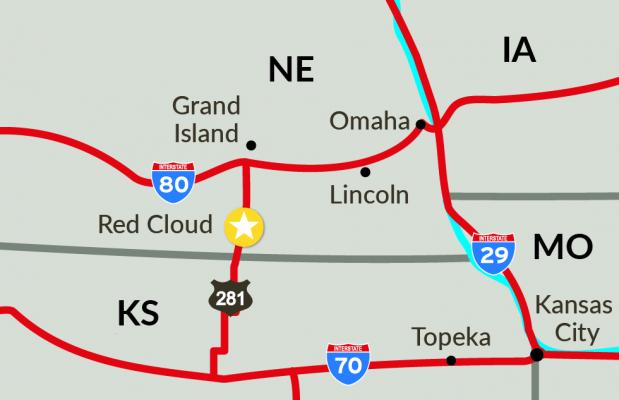History of Red Cloud
History of Red Cloud
Red Cloud (pop. 1020) was founded early in 1871 on homestead land filed upon by a group that included Silas Garber, who would later serve as Nebraska’s Governor from 1875-79. When Webster County was organized, Red Cloud was voted the county seat. The election was held in Garber’s dugout. The mainline of the Burlington and Missouri River Railway reached the town in 1879, accelerating immigration from the east coast of the United States and abroad, bringing together a colorful variety of cultural heritages, which are depicted wonderfully in the works of Willa Cather, Red Cloud’s most famous former resident.
Willard Thorp, in "American Writing in the Twentieth Century" says, "From the literary standpoint, Red Cloud ranks as one of the most famous villages in American Literature."
Red Cloud is home to the largest living memorial to an author in the country. Willa Cather spent her childhood in this small railroad town, and it is the mission of the Willa Cather Foundation to promote and assist in the development and preservation of the art, literary, and historical collection relating to the life, times, and work of one of America's—and the world's—most beloved and respected authors. As a result of its efforts, the Foundation brings 8,000 to 10,000 visitors to Red Cloud each year.
Red Cloud was a booming, growing pioneer community that saw eight passenger trains a day come through its Burlington Depot. Garber and a group of local business men named the town Red Cloud in honor of the chief of the Oglala tribe of the Teton-Lakota Sioux. Though named for the Sioux leader, Red Cloud is located in what is known traditionally as Pawnee/Otoe territory; there is no evidence of Sioux having been in this area.
For many years, Red Cloud boasted a horse-drawn streetcar railway system with tracks running from downtown to the depot. Lorenzo Oatman, who survived an infamous attack by the Yavapais tribe in Arizona as a small child, ran the Royal Hotel for many years. The Starke Round Barn, built in 1902, is the largest of its type in the state.
During the 1880's Red Cloud served as a division center for the railroad. The architectural design of downtown was established during the prosperous time when many of the first frame and log structures were replaced by more elaborate two-story buildings of brick and stone. The historic brick streets remain in downtown Red Cloud as well as many of the original buildings, including the majestic and refurbished Opera House and the Moon Block which together comprise The National Willa Cather Center. You can learn more about the history of Red Cloud’s historic downtown by visiting www.walkredcloud.com.
Willa Cather, the acclaimed American author, arrived in Red Cloud with her extended family in 1883. Originally settling on a homestead northwest of Red Cloud, within eighteen months, the Cathers were living in the iconic Childhood Home on 3rd and Cedar Streets. Cather's memories of the town and its people inspired six of her twelve novels and many of her most beloved short stories. Many of the sites associated with Cather’s literature have been preserved and the Willa Cather Foundation conducts tours of the 7 buildings owned by the Nebraska State Historical Society and various sites throughout Webster County associated with the Cather Family’s homestead sites. In all, nearly 50 sites associated with Cather and her writings are available for you to visit.

Click here to search past issues of the Red Cloud Chief newspaper from 1873 to 1922.












